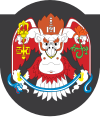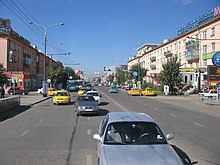Ulaanbaatar


Ulaanbaatar (/ˌuːlɑːn ˈbɑːtər/; Mongolian: Улаанбаатар, pronounced [ʊˌɮaːm‿ˈpaːʰtə̆r] lit. "Red Hero"), or Ulan Bator, is the capital and largest city of Mongolia. The city is an independent municipality not part of any provinces. About half the population of Mongolia, about 1.5 million people, live in the city.[1][2]
Located in the north central part of the country, the city is at an elevation of about 1310 m in a valley on the Tuul River. The city is the country's center for culture, industry and finance, and since it is more than 13 times bigger than the second largest city in Mongolia, Erdenet, it is the country's primate city.[3] Ulaanbaatar is connected by highway to all the major towns in Mongolia and by rail to the Trans-Siberian Railway and Chinese railroad network. The city was founded in 1639 as a Buddhist monastery center and, in the 20th century, grew into a major manufacturing center.
Names
[change | change source]Ulaanbaatar has had many names in its history. From 1639 to 1706, it was known as Örgöö (Mongolian: Өргөө, residence), and from 1706 to 1911 as Ikh Khüree (Mongolian: Их = "great", Хүрээ = "camp"), Da Khüree or simply Khüree. Upon independence in 1911,the city's name changed to Niislel Khüree (Mongolian: Нийслэл = "capital", Хүрээ = "camp"). When the city became the capital of the new Mongolian People's Republic in 1924, its name was changed to Ulaanbaatar, literally "red hero", in honour of Mongolia's national hero Damdin Sükhbaatar, that liberated Mongolia from Ungern von Sternberg's troops and Chinese occupation with the Soviet Red Army. In Europe and North America, Ulaanbaatar was generally known as Urga (from Örgöö) or sometimes Kuren (from Khüree) or Kulun (from
Geography
[change | change source]Ulaanbaatar is at about 1350 meters (4430 ft) above sea level. For this high elevation, and for the high latitude, and location hundreds of kilometres from any coast, Ulaanbaatar is the coldest national capital in the world, with a subarctic climate.
History
[change | change source]Most important events:
- 1639: The city was Founded.
- 1778: the city settled for good at its current location, near the confluence of the Selbe and Tuul rivers and beneath Bogd Khan Uul, back then also on the caravan route from Beijing to Kyakhta.
- 1911: Mongolian leaders in Ikh Khüree for Naadam met in secret and resolved upon independence from China for their country. On December 29, 1911, the Bogd Khan was declared ruler of an independent Mongolia.
- 1919: the city was occupied by Chinese troops
- 1921: the city has been controlled first by Baron Ungern's Whites Soldateska, and in July to the Soviet-supported Mongolian troops controlled by Sükhbaatar.
- October 29, 1924: the town was renamed to Ulaanbaatar ("red hero") in honour of Sükhbaatar.
- 1956: The Transmongolian Railway, connecting Ulaanbaatar with Moscow and Beijing, was completed.
- Many of the temples and monasteries of pre-socialist were destroyed following the anti-religious purges of the late 1930s.
- After the growth of 1990 many buildings as, cinemas, shops were built. Now the biggest cinema is Urguu and Tengis cinema. Main shopping district is 3rd and 4th distirict.
- 2008, Ulaanbaatar was the scene of riots after the opposition Mongolian Democratic Party protested its defeat by the MPRP in parliamentary elections.
Administration and subdivisions
[change | change source]Ulaanbaatar is divided into nine districts (Düüregs): Baganuur, Bagakhangai, Bayangol, Bayanzürkh, Chingeltei, Khan Uul, Nalaikh, Songino Khairkhan, and Sükhbaatar. Each district is subdivided into Khoroos. The capital is governed by a city council (the Citizen's Representatives Hural) with forty members, elected every four years. The city council appoints the mayor. Ulaanbaatar is governed as an independent first-level subdivision of Mongolia, separate from Töv Aimag, the province that surrounds Ulaanbaatar.
Education
[change | change source]Ulaanbaatar has several major universities:
- National University of Mongolia
- Science and Technological University of Mongolia
- Mongolian University of Life Sciences
- University of Health and Medical Science
- Pedagogical University
- University of Art and Culture.
And a big library, The National Library of Mongolia.
Important places
[change | change source]
Most important places in Ulaanbaatar:
- The Choijin Lama Monastery, a Buddhist monastery that was completed in 1908. It escaped the destruction of Mongolian monasteries when it was turned into a museum in 1942.
- The Gandantegchinlen Khiid Monastery, which dates to the 19th century. Its most famous attraction is a 26.5-meter-high golden statue of Migjid Janraisig.
Choijin Lama Monastery and Gandantegchinlen Khiid Monastery are two of the very few in Mongolia to escape the destruction of Mongolian monasteries under Khorloogiin Choibalsan.
Ulaanbaatar has several museums dedicated to Mongolian history and culture.
- The Natural History Museum features many dinosaur fossils and meteorites found in Mongolia.
- The National Museum of Mongolian History.
- The Zanabazar Museum of Fine Arts contains a large collection of Mongolian art, including works of the 17th century sculptor/artist Zanabazar, as well as Mongolia's most famous painting, One Day In Mongolia by B. Sharav.
- The Winter Palace of the Bogd Khan remains as a museum of the last king of Mongolia (1911-1924).
- The Ulaanbaatar Opera House hosts concerts and musical performances.
- Sükhbaatar Square, in the government district, is the center of Ulaanbaatar. In the middle of Sükhbaatar Square, there is a statue of Damdin Sükhbaatar on horseback.
- The Zaisan Memorial, a memorial to Russian soldiers killed in World War II, sits on a hill south of the city.
- National Sports Stadium is the main sporting venue. The Naadam festival is held here every July.
- The Gorkhi-Terelj National Park.
Symbols
[change | change source]
The official symbol of Ulaanbaatar is the garuḍa, a mythical bird in both Buddhist and Hindu mythology called Khan Garuda or Khangar'd by Mongols.
Flag
[change | change source]The city’s flag is sky blue with the garuḍa arms in the center.
Sister cities
[change | change source] Seoul, South Korea
Seoul, South Korea Moscow, Russian Federation
Moscow, Russian Federation Denver, Colorado, USA
Denver, Colorado, USA Sapporo, Japan
Sapporo, Japan Taipei, Taiwan
Taipei, Taiwan Hohhot, People's Republic of China
Hohhot, People's Republic of China
References
[change | change source]- ↑ Mongolian Statistical Information Service
- ↑ "Mongolia: Provinces, Major Cities & Urban Settlements – Population Statistics, Maps, Charts, Weather and Web Information". Retrieved 2017-11-25.
- ↑ "List of cities in Mongolia". Wikipedia. 2018-02-16.

